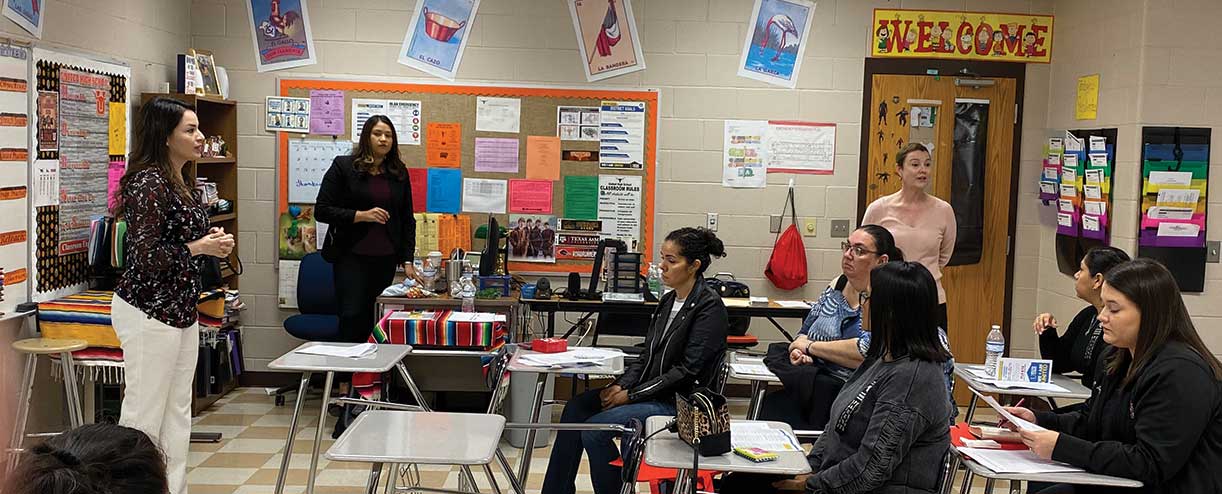Districts Look for Ways to Address Student Mental Health
United ISD Superintendent David Gonzalez knows what it’s like to lose a student to suicide. In 2005, during his first year as a middle school principal, a sixth-grade student at Gonzalez’s school took his life.
“This little boy was really reserved, and unfortunately, he hung himself,” Gonzalez recalled. “As principal, I was the one who had to meet with the parents, and I felt so inept.”
The experience stuck with Gonzalez. When he became superintendent of UISD in Laredo in July 2021, he knew addressing mental health and suicide prevention needed to be a top priority for the district. During the 2021-22 school year, UISD increased parent and staff training on mental health, developed a new mental health website to share relevant resources, and instituted Signs of Suicide, an evidence-based suicide prevention program for schools.
“I’ve always preached as an administrator that it’s not just about the three Rs. Our job is to teach not just the academic side. We need to teach the whole child,” said Gonzalez.
Studies conducted over the past decade have confirmed that adolescent mental health is a growing concern across the country. According to the U.S. Centers for Disease Control and Prevention’s Youth Risk Behavior Survey, the percentage of high school students who reported persistent feelings of sadness or hopelessness increased by more than 10% from 2009 to 2019, while the percentage of those who reported seriously considering suicide increased by 5%.
The COVID-19 pandemic has brought the issue into even sharper focus. Lockdowns, virtual schooling, decreased social interactions, and the high death tolls suffered by some communities have left students struggling. In the midst of all this, students, staff, parents, and district leaders are asking the question — what role do schools play in addressing student mental health?
Mental Health and Academic Success
According to Linda Garza, a licensed specialist in school psychology at UISD, addressing student mental health is “part of the new leadership challenge” for school districts. It makes sense for schools to be invested in mental health, said Garza, because of the deep connection between mental health and academic success.
“If a child does not have the skills to pay attention, to sit down, to ask the questions, and if they don’t have good peer relationships or good relationships with teachers, they can’t advance in academics,” Garza said. “All the research shows us that the moment we start providing those children with counseling services, with social emotional learning, you have an increase in standardized assessments.”
In a July 2022 Education Week webinar, panelist Clayton Barksdale, assistant principal at Cleveland Central High School in Cleveland, Mississippi, echoed those concerns. “If a child doesn’t feel safe, he or she may not be able to learn because he doesn’t feel like this is a safe learning environment — safe from any kind of violence, but also safe to be themselves,” said Barksdale. “These are children that are still growing, and they are very sensitive to everything around them, any kind of criticism.”
At Alice ISD in South Texas, a program called Capturing Kids’ Hearts provides district staff with the training and resources they need to help develop a positive classroom environment.
“Our kids sometimes may not have that socialization, especially coming back from a COVID year, so building those relationships and those social contracts, that was a big initiative for us,” said Gracie Garcia, AISD’s executive director of teaching and learning.
Capturing Kids’ Hearts consultants provide classroom observations to monitor implementation and support teachers as needed. The program, already in its third year of operation, has been a critical part of the district’s mental health strategy, said Erika Vasquez, AISD’s executive director of leadership and school improvement.
“We spend a lot of time with these kids,” said Vasquez. “They’re with us for over eight hours sometimes, and for some families and students, we’re the only thing that they have, so it’s important that we address that.”
Staffing and Resource Challenges
One of the biggest obstacles to providing mental health resources in schools is inadequate staffing. The Texas Education Agency recommends a ratio of one counselor for every 250 students. But a Houston Chronicle investigation conducted in March 2022 found that 98% of Texas schools fall short of that standard.
For school psychologists, the figures are even more grim. According to the National Association of School Psychologists, districts should employ one psychologist for every 500 students. Only 25 districts in Texas met that standard for the 2020-21 school year.
Ileana Moreno, a licensed specialist in school psychology at UISD, said much of the concern stems from a lack of awareness about staffing needs and confusion surrounding the differences between school counselors, who provide general counseling and education services, and school psychologists, who focus on comprehensive mental health care for students.
“If you’re not aware that you need the person, if you don’t know who they are and what they do, why would you allocate funds?” said Moreno. “[Some districts] spend hundreds of thousands of dollars on academic interventions, but when you think about it, had you spent that money and got a person or that emotional behavioral piece, research shows when you have that you increase your standardized assessment as opposed to an intervention.”
But it’s not just academic success that is affected when schools take an interest in student mental health, said Nadia Moreno, AISD’s director of school climate transformation grant. According to Moreno, hiring mental health professionals can also impact a school’s attendance and enrollment rates.
“If we have a student who is not attending because they have undiagnosed anxiety, we’re able to recognize that and make the proper referrals, and we see where they start coming to school,” explained Moreno. “These are amazing intervention methods for attendance and dropout. It eventually ends up paying for itself when you hire a mental health specialist.”
Connecting With Parents
Kareeme Hawkins, director of social emotional learning and guidance at DeSoto ISD near Dallas, believes communicating with parents is a particularly important part of any student-focused mental health strategy.
“When parents are taught and understand the importance of what we’re teaching at school, the impact and reach of what we are teaching can be amplified at home,” she said. According to Hawkins, communicating with parents is about more than just sharing updates and providing resources. It involves building relationships with families and developing a collaborative atmosphere.
“The parent is the expert,” she said. “Before you go into having any type of conversation, you remind the parent, ‘These are your babies. You are allowing them to come and meet with me and be in my presence, and we want to have a collaboration.’”
DISD hosts mental health forums in partnership with the city to help address stigmas and educate the community. Hawkins said events like these are a critical part of serving students.
“When we think about addressing social emotional learning and mental health, there are layers to support student growth. The outer ring is the community. From the community, it’s their home life, and from the home life it’s the campus. From the campus, it’s the classroom,” she said. “If each ring understands the importance of this topic, students should hear it continuously, creating multiple direct and indirect touchpoints. The hope is something will stick.”
Building awareness with the larger community is a key part of UISD’s strategy as well. Gonzalez said the district is committed to sharing resources and educating surrounding districts.
“We did a virtual meeting this past spring where we included all the Region 1 districts. We had people from Lubbock and people all over South Texas,” said Gonzalez. “Somebody asked me the other day, ‘[Why do] you invest all this and you open up for other districts when you’re paying for it?’”
But for Gonzalez, it’s not about the money. It’s about the mission.
“We are never going to shy away from helping others,” he said. “In the end, if we can make an impact on someone’s life, it’s worth it. You can’t put a price on it.”





